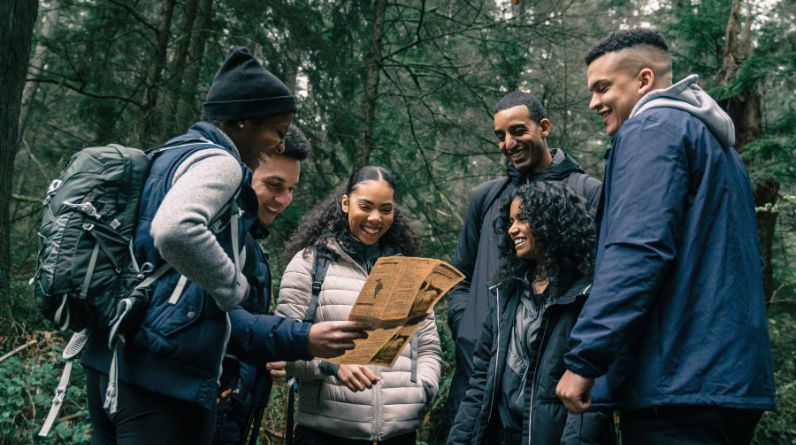
THE CORNERSTONES OF MEANINGFUL CONNECTIONS
In a world bustling with interactions, from professional relationships to personal connections, the ability to build trust and rapport is an invaluable skill. These intangible qualities form the foundation of any healthy and enduring relationship, whether it’s in the workplace, social circles, or even within families. Trust and rapport go hand in hand, creating a harmonious environment where communication flows effortlessly, misunderstandings are minimized, and bonds are strengthened. In this article, we delve into the art of building trust and rapport, exploring its significance, strategies, and the transformative impact it can have on various facets of life.
The Significance of Trust and Rapport
Trust and rapport are the currency of human interactions. They set the stage for genuine connections, fostering open communication, mutual respect, and understanding. These qualities are essential for nurturing positive relationships and facilitating collaboration in both personal and professional realms.
1. Trust: The Bedrock of Relationships
Trust is the cornerstone of any relationship. It’s the confidence and reliance that individuals place in one another, knowing that their intentions, words, and actions are genuine and reliable. Trust is the adhesive that holds relationships together, allowing individuals to be vulnerable, share their thoughts and feelings, and collaborate without the fear of betrayal or judgment.
2. Rapport: Building a Connection
Rapport refers to the sense of mutual understanding and harmony between individuals. It’s the ability to establish a connection that transcends superficial interactions. When rapport is present, conversations become effortless, and people feel valued and heard. Rapport involves active listening, empathy, and the creation of an environment where individuals feel comfortable expressing themselves.
Strategies for Building Trust and Rapport
Building trust and rapport is both an art and a skill. It requires genuine effort, patience, and a willingness to invest in meaningful connections. Here are key strategies to cultivate these qualities:
1. Active Listening:
Active listening goes beyond just hearing words; it involves giving your full attention to the speaker and making a genuine effort to understand their message. Here’s how to enhance active listening:
– Maintain eye contact and face the speaker to show that you’re fully engaged.
– As the speaker is speaking, refrain from responding or interrupting.
– Nod or use encouraging gestures to indicate that you’re following along.
– Reflect on what the speaker is saying and ask clarifying questions to ensure you comprehend their perspective.
– Summarize their points to demonstrate that you’re actively processing the information.
By actively listening, you create an atmosphere where individuals feel heard and valued, strengthening the foundation of trust and rapport.
2. Authenticity:
Authenticity is about being true to yourself and showing vulnerability when appropriate. When you’re genuine in your interactions, others perceive you as sincere and trustworthy. Here’s how to embrace authenticity:
– Share your thoughts, experiences, and opinions honestly, even if they differ from others’.
– Recognize when you don’t have all the information or when you’ve erred.
– Be careful not to put on a front or appear to be someone you’re not.
– Speak from the heart and express your emotions sincerely.
Being authentic fosters connections based on realness and sincerity, which resonate deeply with others.
3. Empathy and Understanding:
Empathy involves stepping into someone else’s shoes and understanding their emotions and perspectives. It demonstrates your sincere concern for their well. Here’s how to cultivate empathy:
– Listen actively and without judgment to truly grasp their feelings.
– Pose open-ended inquiries to compel them to elaborate on their experiences.
– Validate their emotions and show empathy through your tone and body language.
– Offer support and a willingness to help without imposing your solutions.
By displaying empathy, you create a safe space for open dialogue and demonstrate your commitment to understanding others.
4. Consistency and Reliability:
Consistency and reliability are essential for building trust. When you consistently follow through on your commitments, others feel secure in relying on you. Here’s how to demonstrate consistency:
– Keep your promises and meet deadlines.
– Communicate proactively if you anticipate delays or challenges.
– Be honest about what you can and cannot do.
– Avoid making commitments you cannot fulfill.
Your reliability reinforces the belief that you are dependable and can be counted on, contributing to a strong sense of trust.
5. Open Communication:
Open communication involves creating an environment where individuals feel comfortable expressing their thoughts, concerns, and feedback. Here’s how to foster open communication:
– Encourage others to share their opinions without fear of retribution.
– Be receptive to feedback, even if it’s constructive criticism.
– Address conflicts or misunderstandings directly and respectfully.
– Be transparent about your intentions and decisions.
Open communication builds transparency and minimizes misunderstandings, allowing trust to flourish.
6. Respect Boundaries:
Respecting personal boundaries demonstrates your consideration for others’ comfort levels and preferences. Here’s how to navigate boundaries:
– Pay attention to verbal cues that indicate someone’s desire for space or privacy.
– Observe body language to gauge whether someone is receptive to interaction.
– Ask permission before discussing sensitive topics or sharing personal information.
– Respect cultural differences and individual preferences.
By respecting boundaries, you create an environment where individuals feel respected and valued.
7. Non-Verbal Cues:
Non-verbal cues, such as body language, facial expressions, and tone of voice, play a significant role in conveying sincerity and understanding. Here’s how to leverage non-verbal cues:
– Keep your body open to convey approachability.
– Make eye contact to show that you’re engaged and attentive.
– Use facial expressions to reflect your emotions and show empathy.
– Match your tone of voice to the context of the conversation.
Non-verbal cues enhance the depth of communication and provide additional layers of meaning to your interactions.
8. Shared Experiences:
Shared experiences create common ground and foster a sense of connection. Here’s how to emphasize shared experiences:
– Identify topics, interests, or experiences that you have in common.
– Share anecdotes, stories, or challenges that relate to the conversation.
– Use shared experiences as a starting point for deeper discussions.
Shared experiences create a sense of camaraderie and belonging, strengthening rapport.
9. Vulnerability:
Vulnerability involves being open about your own experiences, challenges, and emotions. Here’s how to embrace vulnerability:
– Share personal stories that highlight your growth or struggles.
– Express emotions genuinely and without fear of judgment.
– Admit to your mistakes and show a willingness to learn.
Vulnerability fosters authenticity and encourages others to open up in return.
10. Positive Intent:
Assuming positive intent means giving others the benefit of the doubt and approaching interactions with a constructive mindset. Here’s how to cultivate positive intent:
– Interpret actions and words in a generous and optimistic light.
– Instead of assuming, ask clarifying questions.
– Refrain from jumping to conclusions or assigning negative motives.
Assuming positive intent nurtures an atmosphere of trust and reduces the likelihood of misunderstandings.
The Transformative Impact of Trust and Rapport
The power of trust and rapport extends across various aspects of life:
1. Professional Relationships:
In the workplace, trust and rapport enhance collaboration, boost team morale, and foster a positive work environment. They also facilitate effective leadership and employee engagement.
2. Personal Connections:
In personal relationships, trust and rapport create strong bonds, encourage emotional support, and contribute to lasting friendships and family connections.
3. Customer Relationships:
In business, building trust and rapport with customers leads to loyalty, repeat business, and positive word-of-mouth referrals.
4. Conflict Resolution:
For a problem to be resolved effectively, there must be trust and rapport. They allow individuals to approach disagreements with empathy and open-mindedness.
5. Networking:
In social situations, trust and rapport help individuals network authentically, leading to valuable connections and opportunities.
Conclusion
In our journey to connect with others, we’ve learned that trust and rapport are like the strong foundation of a building. They hold our relationships together and make them meaningful. We’ve seen how important it is to listen to others and be genuine in our interactions. Being understanding and reliable helps us create bonds that last.
Open communication and respecting boundaries make our connections smoother and more enjoyable. Simple things like body language and shared experiences can bring us closer. Being open about our own feelings and showing kindness in our interactions can create a warm atmosphere.
As we wrap up our exploration, it’s clear that trust and rapport are the glue that makes our relationships stick. They make it easier to understand and get along with others. By practicing these principles, we can build bridges of connection and make our interactions more rewarding. So, let’s keep these ideas in mind as we continue our journey of building meaningful connections with those around us.
Frequently Asked Questions
1. Can trust be rebuilt after it’s been broken?
Rebuilding trust is like putting together a puzzle. It takes time and effort to mend what was broken. Honest conversations are the glue that holds the pieces in place. Being accountable for mistakes and consistently showing that you’ve changed helps rebuild the foundation of trust. It’s like taking small steps towards each other, until one day, the bridge is strong again.
2. How do I establish rapport in a professional setting?
Think of rapport as a friendly handshake with your actions. Actively listen to colleagues, ask about their interests, and share a bit about yourself too. It’s like finding a common thread in the tapestry of work. Just remember, it’s less about impressing and more about connecting.
3. Can trust and rapport be one-sided?
Picture trust and rapport as a seesaw. While it’s best when both sides contribute, sometimes one person’s effort can tip the balance. It’s like planting a seed of trust, and even if the other person doesn’t water it right away, they might do so eventually.
4. Can body language impact rapport?
Absolutely! Imagine body language as the silent language of connection. Leaning in slightly shows you’re engaged, just like how eye contact says, “I’m listening.” It’s like having a conversation even before you say a word.
5. What role does vulnerability play in building trust?
Vulnerability is like inviting someone into your home and sharing your stories. It’s the courage to say, “Hey, I’m not perfect either.” When you open that door, it’s like extending a hand and saying, “Let’s walk this journey together.”
6. How do cultural differences affect building trust and rapport?
Cultural differences are like different colors in a mosaic. While they add variety, some things remain constant. Respect and attentive listening are universal brushes that paint a picture of trust, even if the strokes are different.
7. Is building trust and rapport a linear process?
Building trust and rapport is more like a dance than a straight road. Sometimes you take a step forward, other times you sway back. Some connections bloom fast, like a spring flower, while others need more seasons to flourish.
8. Can technology hinder the development of trust and rapport?
Think of technology as a bridge, but not the whole journey. While it helps you cross the river, face-to-face interactions build the stronger foundation. Seeing a smile or hearing a tone adds color to the bridge’s structure.
9. How can I build trust and rapport with remote team members?
Building trust and rapport virtually is like tending to a digital garden. Regular video chats are like watering the plants, while shared jokes and interests are the sunlight. It’s nurturing connections through pixels and screens.
10. Can trust and rapport exist without verbal communication?
Absolutely, it’s like a silent duet. Gestures, expressions, and nods create a rhythm of understanding. It’s the dance of connection that doesn’t need words to convey its melody.





